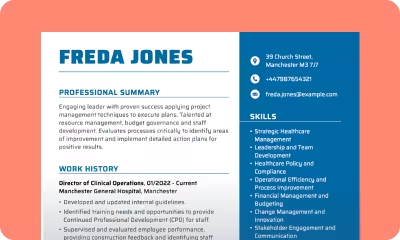- Our customers have been hired by : *Foot Note
Though growing rapidly, the Indian job market has many challenges in store for jobseekers. With high unemployment, the rise of gig jobs, and a relative lack of many quality jobs, those looking to land their dream role in India face quite a task.
In such a situation, a well-crafted curriculum vitae can go a really long way. From making a great first impression among a sea of candidates and highlighting the right set of skills and experience, to demonstrating commitment and initiative, the benefits of having a strong CV even in the toughest employment climate can’t be overstressed.
Of course, a great CV can fail to deliver on its promise if it isn’t formatted according to the rules and conventions to the job market we’re targeting. That’s why we’ve created the following guide, where you’ll learn all about the Indian CV format.
While similar to CV formats in other countries, such as the European CV, professional CV formats in India follow some slightly different conventions. These are important to get right to succeed in the Indian job market.
Below, you’ll find a selection of curriculum vitae samples; a breakdown of what goes into the Indian CV format; dos and don’ts, and everything else you’ll need to ace your very own Indian CV.
SEARCH ALL CV EXAMPLES
Indian CV Writing Format and Structure
While the Indian CV format isn’t wildly different from traditional CV formats you’ll find in other parts of the world, there are some key differences. Mostly, these boil down to the overall presentation, but they also include things such as your photograph, the length, as well as the level of detail you’re required to go into when listing your personal profile.
Contact information
Just as with any other CV, such as the European CV format, the very top of the document should feature the core essentials – i.e. your contact information. These are:
- Your full name
- Home address
- Email address
- Phone number
However, you may also choose to include some extras such as your LinkedIn profile, your website, or a professional portfolio, especially if you feel like they might help you showcase your fitness for the role.
A photograph
Although including a photograph is a practice that has been phased out in many countries around the globe, places such as India still place great value on a good headshot. Make sure to select a high-resolution photo, where you’re dressed in business attire and looking presentable.
Of course, do bear in mind that there are exceptions to every rule, and if you feel like your particular industry may hold different ideas on the subject of including a photograph, stick with your gut.
Summary statement
Similarly to the traditional CV format, the Indian CV also requires you to include a personal statement. This should be a well-worded summary of you as a candidate, as well as what it is you bring to the table. Aim for 3-5 sentences and keep it punchy and relevant to the job you’re applying for.
Personal profile
Now, the level of personal detail that employers expect you to include is probably the biggest difference between the CV format in India and CV formats in other geographies.
Your Indian CV should feature things such as your date of birth, your gender, your nationality, languages spoken, and even your marital status!
Work experience
While there is some debate around whether to feature educational achievements or work experience first within the Indian CV format, a good rule of thumb is to feature the one you feel represents you and your qualifications best at this point, first.
Start with your most recent position first, and be sure to include 3-5 bullet points regarding your responsibilities.
Education
Like with your work history, use the reverse-chronological order when listing your educational achievements to date.
Education carries great importance in India. For this reason, it’s worth going into more detail regarding things such as grades, awards or honours you’ve received throughout.
Skills
The Indian CV format takes a slightly different approach with regards to how your skills are presented. Technical skills along with any relevant certifications are usually kept separate from the general skills section (usually made up of soft skills).
As such, reserve a separate section for any technical skills related to the role you’re applying for and place it before the work experience section. Your general competencies can come after “Education”.
Free CV Template (India)
Below, we’ve created an Indian curriculum vitae sample, so you can get an idea of the kind of information to include and the order to list it in.
Asha Sharma
120 Masjid Road
New Delhi, DL 110025
+91 1234567890
asha.sharma@example.com
Personal Statement:
Dedicated and passionate educator with 8 years of experience in teaching English literature. Committed to fostering a positive learning environment and empowering students to achieve their full potential. Seeking an opportunity to contribute my expertise and enthusiasm to a dynamic educational institution.
Technical skills:
- Classroom management
- Lesson planning
- Coaching
- Microsoft Office (Word, Excel, and Powerpoint)
- File management
- WebCT
- Educational copyright
- Computer security
Education:
September 2014 – May 2018
University of Delhi
Bachelor of Education
English Literature
Dissertation: “Modernist Poetry: A Stylistic and Linguistic Analysis of T.S. Elliot”
Supervisor: Prof. Juhi Philip
Grade: A+
September 2010 – May 2014
University of Delhi
Bachelor of Arts
English Honours
Dissertation: “The Postcolonial Novel: Identity and Displacement”
Supervisor: Prof. Priyanka Bhatiya
Grade: A
Work Experience:
August 2022 – Present
St. Xavier’s Senior Secondary School, New Delhi, DL
English Teacher
- Developed and implemented engaging lesson plans for English literature classes in accordance with CBSE curriculum standards.
- Utilised a variety of teaching strategies, including group discussions, debates, and multimedia presentations, to accommodate diverse learning styles.
- Established a supportive and inclusive classroom environment where students felt encouraged to express themselves and explore literary concepts.
- Leveraged technology such as interactive whiteboards and educational software to enhance classroom instruction and student engagement.
- Collaborated with colleagues to develop interdisciplinary projects and initiatives aimed at promoting cross-curricular learning.
May 2019 – August 2022
Modern Public School, Gurugram, HR
Assistant English Teacher
- Assisted in the delivery of English language and literature lessons for middle school students.
- Provided individualised support to students with special learning needs, including English language learners and students with learning disabilities.
- Participated in staff meetings and professional development workshops to stay updated on best practices in teaching and learning.
- Contributed to the development and evaluation of curriculum materials, assessments, and instructional resources.
- Actively participated in school events and extracurricular activities, including literary festivals and drama productions.
Competencies:
- Communication
- Leadership
- Teamwork
- Adaptability
- Conflict resolution
- Critical thinking
- Time management
- Multitasking
Personal profile:
Languages: Hindi, Gujarati, English
Date of Birth: 05/05/1991
Gender: Female
Marital Status: Single
Nationality: Indian
Notice period: 3 months
Ready to Relocate: Yes
Indian CV formats in different samples (PDF & Word)
While adhering to the general countrywide format is important, other things matter, too. Think clarity, presentation, and sticking to that which is relevant to include. To demonstrate this fact, we’ve prepared a few samples of the Indian CV format used across different professions.
From doctor to lawyer, the CV examples below will guide you through this particular curriculum vitae format no matter what career sector or experience level you’re embarking on.
CV format for doctors in India
High-impact careers such as those in medicine are known for their many different stages. As such, the CV format for doctor’s needs to be able to clearly present a whole load of information in a way that is easy to digest and doesn’t bore the reader before they make it past the first section. This is especially important given that the Indian CV format tends to run a bit longer than CV formats found in other corners of the world.
CV format for teachers in India
The academic CV format, such as that used by teaching professionals, is often required to be at least two pages long. This means that the CV template used by teachers needs to be able to both: retain the reader’s attention for a good few minutes and include plenty of detail.
CV format for lawyers in India
A good lawyer CV also needs to balance detail and relevance effectively. Apart from that, the information needs to be presented in a way that is efficient and professional, so as to reassure hiring managers of the candidate’s competence.
How to make an Indian CV format
Now that we’ve covered the very basics of an Indian CV, and you’ve had a look at some CV formats in India, it’s time to go over some key steps to cover when creating yours.
While the curriculum vitae format in India may not differ greatly from other CV types, there are some crucial differences that need to be heeded as you’re crafting your own copy of the document.

Choose the right photo
Including a photograph in your CV may come with some extra stress. After all, we all know first impressions can make or break your chances of getting people to truly listen to what you have to say. And surely nothing makes a stronger impression than how we look.
Worry not, however! Unless you’re applying for a modelling gig, your physical appearance only counts in so far as you’re looking presentable and tidy. So, make sure to pick a high-resolution image that actually resembles you, without any distractions in the background, or other people in the photograph.
A good rule of thumb is to have your face take up at least 60% of the frame. Feel free to crack a smile, and don’t stress over the outfit too much. Just wear what you’d normally wear to work.
Include all the necessary info in your personal profile
Now, as we mention above, the biggest difference between Western-style CV formats and the CV format in India is how much personal detail you’re expected to provide in your resume. While applicants in, let’s say, the UK wouldn’t normally dream of disclosing their marital status or even their exact date of birth, this sort of information is very much required in India.
Write a future-oriented summary statement
Also known as your personal statement, the summary statement is a short introduction to you as a candidate that sits at the top of your CV. Usually 3-5 sentences long, it’s there to let employers know what it is you have to offer and how everything you detail in your CV makes you a fit candidate for the role you’re pursuing.
Easy enough, right? Well, when it comes to the Indian CV format, employers need candidates to do slightly more. As well as summarising your best qualities, you need to take a future-oriented approach, i.e. outline your goals and aspirations, and what it is you’re looking to achieve out of your job-seeking efforts.
Emphasise your skills and certifications
The Indian CV format places a lot of value on showcasing certifications and technical skills. These are usually displayed just before the work experience part of your CV, and often categorised based on areas of expertise. Make sure to emphasise those that are directly relevant to the job, and avoid exaggerating or misrepresenting your capabilities.
Also, bear in mind that your Indian CV should also feature a separate general skills section, which is where you list softer skills such as communication and teamwork. This section comes after “Education”.
Mind the length
While Western-style CVs are only one-page long, unless you’re pursuing jobs in academia, in India, this isn’t the case. Recruiters and hiring managers typically expect a standard CV to be at least two (if not three) pages long. Of course, this makes sense when you consider all of the other requirements we mention above.
So, make sure to get it all in there, and if you’re still struggling to make the minimum length, add more detail, e.g. to your work experience section.
Download the Indian CV format
Despite its very own challenges, the Indian job market has a lot in store for today’s job seekers. And though agriculture still dominates the Indian workforce, other industries such as finance, medicine, IT, and entertainment (to name a few) are also going strong.
Browse our CV builder to find pre-loaded CVs for any type of role and industry you’re interested in. For example…
Indian CV for a banker
Indian CV for a project manager
Indian CV for a lawyer
Dos and Don'ts
DO
Do: Consider industry norms
Just as with everything else in life, with your Indian CV format, it’s worth keeping in mind that there are exceptions to every rule. It may be the case that your specific industry expects candidates to, for example, avoid including certain elements such as a photograph, or even craft a longer CV than normal. To avoid making unnecessary mistakes, always consider industry-specific norms when creating your CV.
Do: Tailor to the job application
Whether you’re working with an Indian CV format, a South African or a European one, one thing that you can count on is that employers will look for how relevant your skills and experience are to the job they’re hiring for. Customising your CV to the job description and including the right set of keywords are the two things you always need to make sure you’re doing. After all, what good is a great CV if it doesn’t offer hiring managers the required potential?
Don’t
Don’t: Make your CV too minimalistic
The Indian CV format doesn’t just vary in terms of length – it also varies when it comes to the overall presentation. Indian CVs are often more decorative and colourful than Western-style CVs, so feel free to experiment a bit with elements such as borders, colours and fonts to make your resume eye-catching. While a minimalistic CV may go a long way in the West, employers in India aren’t as impressed by minimalism.
Don’t: Forget to quantify your achievements
Whether you’re describing your past responsibilities or crafting your “Education” section, it’s important to provide tangible evidence of your achievements. So, for example, this could relate to the class size you taught, the number of projects you’ve led, or even things such as specific grades you received while studying.
Tips for working with the Indian CV format - Takeaways
We hope you’re feeling a lot more confident about working with the Indian CV format now that we’ve come to the end of this guide. Before you go, below is a refresher on all the things we cover above. Give them a read to make sure your Indian curriculum vitae is the very best it can be.
Include a high-resolution photograph
Indian employers and hiring managers place great value on how their applicants present themselves. Make sure to impress them with a good-quality image that clearly features you against a plain background, sporting the kind of attire you’d wear on your first day on the job.
Write a future-oriented summary statement
Give future employers a taste of what you offer with a short personal statement summarising your most notable achievements and skills. Make sure to describe your hopes and aspirations for the future, and what it is you hope to get out of your next role.
Provide enough personal detail
Help recruiters get to know you, by providing enough personal detail, such as your full name, date of birth, your gender, nationality, languages spoken, and marital status. If relevant, you may also touch upon your readiness to relocate.
Organise your skills correctly
Make sure your technical skills and certification that supports them are neatly organised into their separate section and featured prominently below your summary statement. Create another section for all of your soft skills and place it after Education.
Make the required length
Like it or not, a one-pager just won’t cut it for the Indian CV format. Instead, aim for two or three pages – this shouldn’t be a problem if you’re including all of the sections and detail we mention in this piece.
Make it fun
If you’ve ever wished your CV could be just a little bit less boring, you’ll love working with the Indian CV format. Here, you’ll get the opportunity to experiment with colours, fonts, borders, and all the other fun elements that may not be recommended when working with the traditional, Western CV format.
Quantify your achievements
As always, it’s not enough to just say you’re a great candidate – you have to back it up with evidence. Provide concrete numbers and necessary detail to demonstrate your fitness for the role you’re pursuing.
Tailor to the job description
Whatever CV format you’re working with, employers always want to see how what you’re offering matches up with what they’re looking for. Use the job description to help you choose the right keywords and accentuate the most important skills within your CV, and wow potential employers from the get-go.
Get started with your Indian CV
As you’ll have learned from reading the above piece, the Indian CV format is quite different from those found in other parts of the world. Whether it be the length, the headshot, or the fact that you’re required to include so much personal information about yourself, CV requirements in India are a different ball game altogether.
Do bear in mind, though, that at the end of the day employers are still looking for the very same things – the right candidate for the role they’re advertising. That’s why it’s important not to get hung up on these differences and make sure your curriculum vitae is still the very best it can be.
To help you do just that, our CV builder awaits! Get started with one of our shiny CV templates, add all of the necessary information, and top it all off with our professionally written content to wow hiring managers. Edit and move around all the sections as needed, and create your very own Indian CV.
Create your Indian CV in 3 simple steps
Create your Indian CV in 3 simple steps
- Choose from one of many available CV formats
- Supplement with professionally written content
- Download your brand new CV and get your dream job!
*The names and logos of the companies referred to above are all trademarks of their respective holders. Unless specifically stated otherwise, such references are not intended to imply any affiliation or association with myperfectCV.



